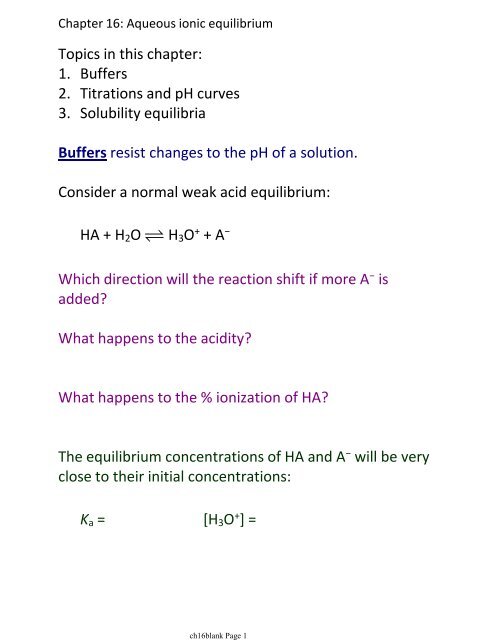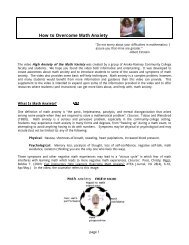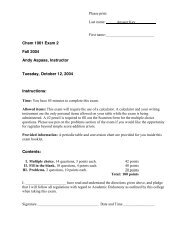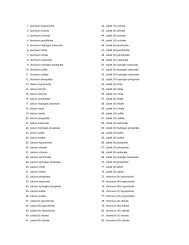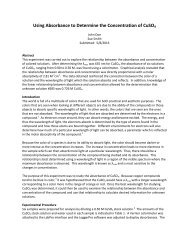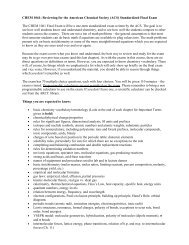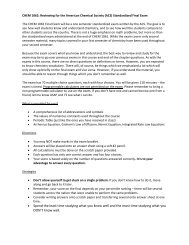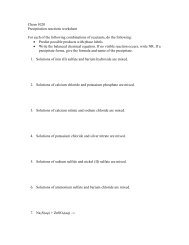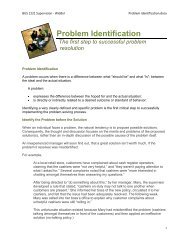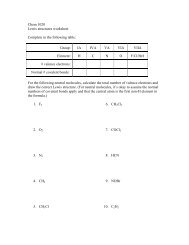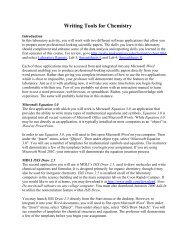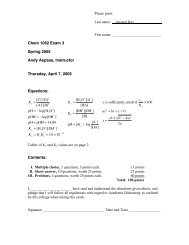Buffers 1. Titrations and pH curves 2. Solubility equilibria 3. Topics in ...
Buffers 1. Titrations and pH curves 2. Solubility equilibria 3. Topics in ...
Buffers 1. Titrations and pH curves 2. Solubility equilibria 3. Topics in ...
Create successful ePaper yourself
Turn your PDF publications into a flip-book with our unique Google optimized e-Paper software.
ch16blank Page 3Buffer <strong>pH</strong> calculationWhat is the <strong>pH</strong> of a solution of0.10 M ammonium chloride <strong>and</strong> 0.15 M ammonia?
ch16blank Page 4Add<strong>in</strong>g a strong acid or base to a buffer<strong>Buffers</strong> resist changes <strong>in</strong> <strong>pH</strong> because they conta<strong>in</strong> bothan acid <strong>and</strong> a base.In a buffer of HA <strong>and</strong> A − :What happens when you add H 3 O + to the buffer?What happens when you add OH − to the buffer?
ch16blank Page 5Add<strong>in</strong>g a strong acid or base to a bufferCalculate the <strong>pH</strong> when 0.0050 mol strong acid is added toa buffer which conta<strong>in</strong>s 0.010 mol NH 4+ <strong>and</strong> 0.015 molNH 3 ?<strong>1.</strong>Stoichiometry calculation<strong>2.</strong>Equilibrium calculation (H-H equation)
ch16blank Page 6Add<strong>in</strong>g a strong acid or base to a bufferA buffer conta<strong>in</strong>s 0.47 M HNO 2 <strong>and</strong> 0.61 M NaNO 2 . Whatis the <strong>pH</strong> of this buffer?What is the <strong>pH</strong> when 8.7 mL of 0.128 M NaOH is addedto 243 mL of the buffer solution?
ch16blank Page 7Buffer capacity <strong>and</strong> buffer rangeRelative amounts of acid <strong>and</strong> base:A buffer is most effective when the ratio of A − to HA isbetween 0.1 <strong>and</strong> 10. What <strong>pH</strong> range does thiscorrespond to?So, when creat<strong>in</strong>g a buffer, make sure the pK a of theacid is as close to the desired <strong>pH</strong> as possible.What is the <strong>pH</strong> range of a buffer created by formicacid (pK a = <strong>3.</strong>74) <strong>and</strong> its conjugate?What ratio of the base to acid would be needed tomake a <strong>pH</strong> 4.00 buffer?Absolute concentrations of acid <strong>and</strong> base:A buffer is effective when the concentrations of A −<strong>and</strong> HA are at least 10x greater than theconcentration of an added strong acid or base.
ch16blank Page 8<strong>Titrations</strong> <strong>and</strong> titration <strong>curves</strong>Known concentrationUnknown concentrationTitration curve:graph of <strong>pH</strong> vs volumeof solution addedStrong acid titrated with strong base<strong>pH</strong>Vol NaOH added (mL)
ch16blank Page 9Strong acid titrated with strong base50.0 mL HCl of unknown concentration is titrated with0.150 M NaOH. The titration curve's only <strong>in</strong>flection po<strong>in</strong>toccurs at 40.0 mL of added base. What was the <strong>in</strong>itial HClconcentration?What was the <strong>in</strong>itial <strong>pH</strong> of the HCl solution?What is the <strong>pH</strong> after 60.0 mL NaOH is added?
ch16blank Page 10Weak acid titrated with strong base<strong>pH</strong>Vol NaOH added (mL)HA + OH − →Buffer region:At the midpo<strong>in</strong>t (half-equivalence pt):
ch16blank Page 11Weak acid titrated with strong base40.0 mL of 0.0788 M HA are titrated with 0.100 M NaOH.What is the volume of NaOH added at the equivalencepo<strong>in</strong>t?If the <strong>pH</strong> = 4.88 at the midpo<strong>in</strong>t, what is K a <strong>and</strong> what isthe <strong>pH</strong> at the endpo<strong>in</strong>t?
ch16blank Page 12Weak acid titrated with strong baseWhat is the <strong>pH</strong> after 10.0 mL 0.100 M NaOH is added to40.0 mL of 0.0788 M HA (the titration on the last page)?
ch16blank Page 13Weak acid titrated with strong base75.0 mL of a weak acid are titrated by 0.125 M NaOH.The endpo<strong>in</strong>t occurs at 6<strong>2.</strong>1 mL of added base, <strong>and</strong> the<strong>pH</strong> at the midpo<strong>in</strong>t is <strong>3.</strong>1<strong>2.</strong> What is the <strong>in</strong>itial acid concentration? What is the K a ? What is the <strong>pH</strong> <strong>in</strong>itially <strong>and</strong> at the equivalencepo<strong>in</strong>t?
ch16blank Page 14Weak base <strong>and</strong> polyprotic acid titrationsWeak base titr by strong acid<strong>pH</strong>Vol HCl added (mL)Polyprotic acid titr by strong base<strong>pH</strong>Vol NaOH added (mL)
ch16blank Page 15<strong>pH</strong> IndicatorsMake sure the color range of your <strong>in</strong>dicator is with<strong>in</strong> themost vertical part of the titration curve!
ch16blank Page 16<strong>Solubility</strong> <strong>equilibria</strong>Compounds we called "<strong>in</strong>soluble" before, are actuallyvery slightly soluble, governed by an equilibrium:CaF 2 (s) ⇌ Ca 2+ (aq) + 2 F − (aq)<strong>Solubility</strong> product constant, K sp for CaF 2 =Molar solubility, S =mol solute (when saturated)L solutionIf the molar solubility, S, of PbF 2 is <strong>2.</strong>61 x 10 −3 M, what isthe K sp of PbF 2 ?PbF 2 (s) ⇌What are the ion concentrations?
ch16blank Page 17Calculat<strong>in</strong>g molar solubilityIf K sp for Mg(OH) 2 is <strong>2.</strong>06 x 10 −13 , calculate the molarsolubility, S.
ch16blank Page 18K sp <strong>and</strong> relative solubilityDirect comparison of K sp values only works betweencompounds that dissociate <strong>in</strong>to the same number ofions.Which is the most soluble?BaF 2CaF 2Fe(OH) 2PbCl 2PbBr 2K sp = <strong>2.</strong>45 x 10 −5K sp = <strong>1.</strong>46 x 10 −10K sp = 4.87 x 10 −17K sp = <strong>1.</strong>17 x 10 −15K sp = 4.67 x 10 −6
ch16blank Page 19Common Ion EffectHow is solubility affected when more ions are added tothe solution?Ca(OH) 2 (s) ⇌ Ca 2+ (aq) + 2 OH − (aq); K sp = 4.68 x 10 −6To this solution, we add Ca(NO 3 ) 2Na + , K + , NH 4+ ,NO 3− , C 2 H 3 O 2−make compoundstotally solubleThe reaction shifts:A common ion <strong>in</strong> solution will _________ a compound'ssolubility.
ch16blank Page 20Common ion effect calculationWhat is S for Ca(OH) 2 ? K sp = 4.68 x 10 −6What is S for Ca(OH) 2 <strong>in</strong> 0.10 M Ca(NO 3 ) 2 solution?
ch16blank Page 21Effect of <strong>pH</strong> on solubilityIf a compound's dissociation produces a basic anion(usually OH − , CO 32−, S 2− ), solubility is dependent on <strong>pH</strong>.CaCO 3 (s) ⇌ Ca 2+ (aq) + CO 32−(aq)Addition of strong acid to this solution…A similar effect occurs when base is added to a solutionwhich conta<strong>in</strong>s an acidic cation.
ch16blank Page 22PrecipitationTo calculate whether or not a precipitate will form, takethe given ion concentrations <strong>and</strong> calculate Q (thereaction quotient).If Q = K sp :If Q > K sp :If Q < K sp :A newly mixed solution has these ion concentrations:[Pb 2+ ] = 0.25 M, [Cl − ] = 0.017 M. Will a precipitate form?K sp (PbCl 2 ) = <strong>1.</strong>17 x 10 −5 .


